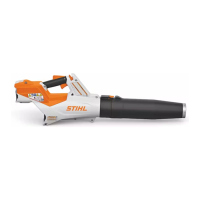0458-008-8201-A
10
English
5 IMPORTANT SAFETY INSTRUCTIONS
■ Use of this blower can generate dust and other
substances containing chemicals known to cause
respiratory problems, cancer, birth defects and other
reproductive harm.
– Consult governmental agencies such as ECCC,
CCOHS and PHAC and other authoritative sources
on hazardous materials if you are unfamiliar with the
risks associated with the particular substances with
which you are working.
■ Inhalation of certain dusts, especially organic dusts such
as mold or pollen, can cause susceptible persons to have
an allergic or asthmatic reaction. Substantial or repeated
inhalation of dust or other airborne contaminants,
especially those with a smaller particle size, may cause
respiratory or other illnesses.
– Control dust at the source where possible.
– To the extent possible, operate the blower so that
the wind or operating process directs any dust, mist
or other particulate matter raised by the blower away
from the operator.
– When respirable dust or other particulate matter
cannot be kept at or near background levels, always
wear a respirator that is approved by PHAC and
rated for worksite-specific conditions. Follow the
recommendations of governmental authorities (e.g.,
CCOHS/PHAC) and occupational and trade
associations.
■ If the surrounding ground is coated with a chemical
substance, such as pesticide or herbicide:
– Read and follow the instructions and warnings that
accompanied the substance coating the vegetation
or surrounding ground.
5.6.4 Operating Instructions
WARNING
■ In the event of an emergency:
– Switch off the motor immediately and remove the
connecting cord from the blower.
■ The blower fan between the air intake and output opening
rotates whenever the motor is running. To reduce the risk
of injury from contact with the blower fan:
– Never operate the blower with a missing, cracked or
worn intake screen or housing.
– Never operate the blower without a properly
mounted blower tube and nozzle.
– Keep hair, loose clothing, fingers and all parts of the
body away from openings and moving parts of the
blower.
■ The air flow from the blower can propel small objects at
high speed. To reduce the risk of eye or other serious
personal injuries to bystanders from blown objects:
– Do not allow the blower to be used as a toy.
– Switch off the blower immediately if you are
approached.
– Keep bystanders and pets at
least 17 ft. (5 m) away when the
blower is running.
– Never direct the air flow toward
bystanders or pets.
5m (17 ft)

